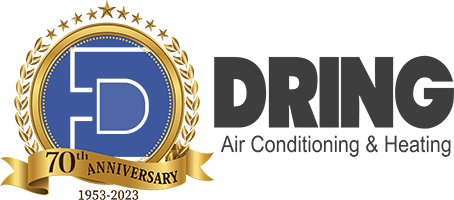One of the most important parts of caring for your Carrollton, TX home is maintaining an efficient and high-performing HVAC system. Heaters, air conditioners, and heat pumps play vital roles in keeping homes habitable. In addition to maintaining safe, comfortable temperatures in building interiors, they also filter indoor air and regulate inside humidity. Staying abreast of the latest regulatory changes impacting the HVAC industry is essential for ensuring that your current and future HVAC equipment is on par with expectations. To help, the following covers three major changes in HVAC for 2023.
1. 2023 Sees the Introduction of a Brand-New AC Refrigerant
For quite some time, homeowners throughout the nation were primed for the phase-out of R-22 refrigerant, or Freon. AC manufacturers have long stopped using this coolant in their equipment designs, and the importation and domestic production of Freon stopped altogether in 2020.
Freon’s first replacement was Puron. Puron, or R-401a, was determined to be a cleaner and more environmentally sustainable option for residential cooling systems. However, with regulators and HVAC manufacturers always moving forward in their efforts to ensure the widespread use of eco-friendly products, even Puron is fast becoming old news.
In 2023, AC equipment manufacturers are transitioning to R-454b or Puron Advance. Throughout 2023, R-401a will remain available for the continued maintenance and repair of existing, Puron-reliant air conditioners. Going forward, R-454b will be the new industry standard until a superior refrigerant eventually takes its place.
If you’ve only recently upgraded your air conditioner to one that uses Puron, you may be worried about what this change means for you. The good news is that fast-changing industry standards don’t immediately render functional equipment obsolete. You can still continue using your current Puron-reliant air conditioner throughout the remainder of its lifespan. When your unit needs to be serviced, we have trained technicians on hand who can meet its full range of needs. However, when this unit reaches the end of its lifespan, your options in air conditioners will be limited to products that use R-454b or better.
2. Updated Standards for the Seasonal Energy Efficiency Ratio (SEER) Rating
One of the most important changes in the HVAC industry for 2023 pertains to how residential cooling systems are rated. In the past, consumers were encouraged to look at the SEER ratings of AC units when making their selections, and AC manufacturers were required to use SEER ratings as their guidelines for minimum efficiency. With higher numbers denoting higher levels of efficiency, a unit’s SEER rating is a measurement of its output throughout the entire cooling season divided by its total energy use over this same period.
Unfortunately, although SEER ratings were sufficiently effective in their time for helping both people and product makers control their carbon footprints, they weren’t an entirely accurate depiction of air conditioner performance in real-world applications. With SEER, air conditioners were field tested in environments that did not adequately account for the air pressure and increased demands applied by central HVAC ducting. As such, SEER ratings have been replaced by SEER2 ratings in 2023. This reflects a dramatic change in how units are tested, and it means that testing results provide better evidence of how efficiently cooling systems perform when installed.
Throughout the nation, minimum efficiency standards for both SEER and SEER2 ratings are broken down by region. For states like Texas in the southeast region, the minimum SEER2 rating for air conditioners is 14.3. This is equivalent to a SEER rating of 15.
As with air conditioners that are still using Puron for refrigerant, if you have an AC unit that conforms to outdated SEER standards, you are not legally obligated to replace it right away. When this unit reaches the end of its lifespan, you can upgrade to an option that’s on par with the latest regulations. However, it’s important to note that both the move away from R-401a refrigerant and the introduction of SEER2 standards have cost benefits for consumers. Not only are these changes better for the natural environment, but the increases in efficiency that they entail can also result in noticeably lower home energy bills.
3. 2023 Has Brought Some Pretty Impressive Tax Incentives for Homeowners
For homeowners in need of new HVAC equipment and homeowners who’ve very recently had new HVAC equipment installed, 2023 is rich with good news. In fact, throughout the year 2032, consumers can now claim up to $3,200 in tax credits for qualifying energy upgrades. These include credits for replacing or improving existing heaters, air conditioners, heat pumps, water heaters, and more. There are even additional credits for making various upgrades to the overall home envelope.
Introduced as part of the Inflation Reduction Act of 2022, these incentives include tax credits of up to $2,000 for the installation of air-source heat pumps. Homeowners can claim up to 30% of their project costs if their chosen models are Energy Star-rated and have SEER2 ratings of 16 or higher. This incentive also applies to non-ducted, certified mini-split heat pumps. If installing a new central air conditioner, you can claim up to $600 or 30% of your project’s total cost for any Energy Star-certified equipment that has a SEER2 rating of 16 or higher.
Annually, you can also claim up to $1,200 in tax credits for installing new windows, adding weatherstripping, increasing your home’s insulation, or choosing insulation with higher R-values. When you schedule your AC or heat pump installation with us, we’ll help you make the most of these incentives. Best of all, 2023’s HVAC tax incentives are additionally retroactively available to homeowners who’ve made these upgrades already and whose equipment was installed and ready for use on or after January 1, 2022.
How to Navigate the HVAC Scene in 2023
Innovations in home cooling equipment are occurring at breakneck speed. This is especially true when it comes to changes that are improving overall system efficiency. For homeowners, learning how to navigate the fast-changing HVAC scene in the most cost-effective way is of the utmost importance. As always, the focus for consumers remains on finding equipment that provides optimum levels of home comfort and safety at an affordable price. We work with our clients as partners in efficiency management. By sharing information on new and upcoming regulatory changes, we help homeowners make informed decisions that are just as beneficial for their budgets as they are for their living environments.
We make recommendations for AC equipment upgrades on a case-by-case basis. You can get one by scheduling a consultation appointment. You might want to swap your current air conditioner for one with an acceptably high SEER2 rating or one that relies on R-454b refrigerant if you’re dealing with recurring repair issues, excessively high cooling costs, or constant problems with indoor humidity or indoor air quality.
For homeowners with air conditioners and heat pumps that are performing exactly as they should, we recommend diligent, ongoing maintenance and advance planning for the replacement needs that will invariably arise at the end of their lifespans. While SEER2 is currently the standard for AC efficiency testing and R-454b is now recognized as the most sustainable, eco-friendly option in residential AC refrigerants, new innovations are bound to arise in the years that lie ahead.
We offer heater and air conditioner repair, maintenance, and installation services. We also provide HVAC air duct installation, heat pumps, and indoor air quality services. If you’re ready to replace the air conditioner in your Carrollton, Texas home, get in touch with Dring Air Conditioning & Heating today!







